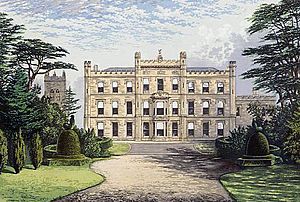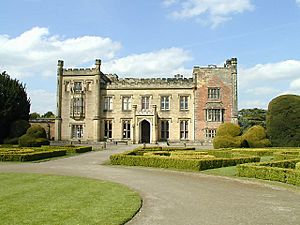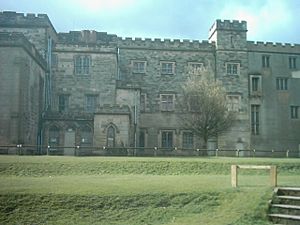Elvaston Castle facts for kids
Quick facts for kids Elvaston Castle |
|
|---|---|

Elvaston Castle in the late 19th century
|
|
| General information | |
| Architectural style | Gothic Revival |
| Location | Elvaston, Derbyshire |
| Country | England, United Kingdom |
| Coordinates | 52°53′34″N 1°23′43″W / 52.89278°N 1.39528°W |
| Construction started | 1815–1829 (Extended and Remodeled) |
| Completed | 1836 (Final Alterations Completed) |
| Owner | Earl of Harrington Derbyshire County Council |
| Design and construction | |
| Architect | James Wyatt, Robert Walker, Lewis Nockalls Cottingham |
|
Listed Building – Grade II*
|
|
| Designated | 2 September 1952 - House 4 August 1984 - Park |
| Reference no. | 1334604 - Country House 1000404 - Park and Garden |
|
Listed Building – Grade II
|
|
| Number of Listings | 14 including Boat House, Coach House, Grotto and Moorish Temple |
Elvaston Castle is a grand old house in Elvaston, England. It's built in a special style called Gothic Revival. The castle and its huge park are now run by Derbyshire County Council. They call it the Elvaston Castle Country Park. This park has about 200 acres (0.8 square kilometers) of woods, open fields, and beautiful gardens.
The main building, Elvaston Castle, is a very important historic site. It's known as a Grade II* Listed building. Sadly, the castle needs a lot of repair work. Because of its condition, you can't go inside. Since 2008, it has been on a list called the Buildings at Risk Register. This list highlights important buildings that need help.
Derbyshire County Council knows the castle needs a lot of money for repairs. It also needs funds to keep it looked after in the future. In 2017, a group called The Elvaston Castle and Gardens Trust was set up. Their job is to take care of the estate once the repairs are finished.
Contents
History of Elvaston Castle
For a long time, until the 1500s, the land where Elvaston Castle stands belonged to a place called Shelford Priory. When monasteries were closed down in England, the King sold the land in 1538. It was bought by Sir Michael Stanhope.
Later, in 1629, another Sir John Stanhope gave the estate to his second son, also named Sir John Stanhope. This Sir John built the first manor house on the site in 1633. It was built in the Elizabethan style.
In the early 1800s, the house was changed a lot. Charles Stanhope, 3rd Earl of Harrington wanted it to look like a grand Gothic castle. He hired a famous architect named James Wyatt. Wyatt designed a new part of the house and many of the rooms inside. He died before the work was finished. Robert Walker continued his designs from 1815 to 1829.
More changes were made in 1836 by architect Lewis Nockalls Cottingham. He updated the Elizabethan part of the house to match the new Gothic style. These were the last big changes, making the castle look like it does today.
During World War II, the castle was used as a college for training teachers. The college moved out in 1947. After that, the house was mostly empty for about 20 years. This started its slow decline.
The Beautiful Gardens
The 3rd Earl of Harrington wanted to improve the castle grounds. He asked a famous landscape designer, Capability Brown, for help. But Brown said no because the land was too flat.
In 1830, Charles Stanhope, 4th Earl of Harrington, hired William Barron to redesign the gardens. The Fourth Earl was very close to his wife, Maria Foote. He wanted the gardens to be a "private and secret beautiful place" just for them.
Barron worked on the gardens for 20 years. He even brought in full-grown trees using a special machine he invented! This was to make the gardens look amazing right away.
The Fourth Earl and his wife loved their garden because it gave them privacy. After their only son died at age four, they became very private. They stayed at the castle and didn't let anyone else enter the grounds.
After the Fourth Earl died in 1851, his brother, Leicester Stanhope, 5th Earl of Harrington, opened the gardens to the public. The gardens became very famous and were known as "a Gothic paradise." They are also listed as a Grade II Listed historic site.
The estate has over 50 other buildings. These include stables, kennels, a walled garden, and several small houses. The gardens themselves are listed as Grade II* on the Register of Historic Parks and Gardens.
Elvaston Country Park
In 1969, the estate was sold to Derbyshire County Council. This happened after a new law called the Countryside Act 1968 was passed. This law suggested creating "country parks" for people to enjoy nature.
The council opened the estate to the public in 1970. Since then, it has been known as Elvaston Castle Country Park. In 1969, parts of Elvaston were also used to film Women in Love, a movie based on a book by D.H. Lawrence.
Elvaston Castle Today
The castle and estate continued to decline after World War II. Even though some restoration work was done, it cost a lot to keep the park running. By 1990, the castle was considered unsafe and closed to visitors. In 2000, the council estimated it cost £500,000 a year to run the park. They also needed £3,000,000 for repairs.
In 2006, a report said the castle and estate needed at least £6.1 million for important repairs. Some groups were interested in helping, but plans didn't work out.
In 2013, the County Council asked The National Trust for ideas on the estate's future. This led to a new plan in 2015. A special board was created to help make the estate a charitable project. This led to the creation of The Elvaston Castle and Gardens Trust in 2017. This group is now working to bring a new future to the estate.
Castle Hauntings
Some people believe the castle is haunted! People who investigate ghosts have visited the castle. They have reported strange noises, unexplained sightings, and objects moving on their own.
The castle is also said to be home to two ghosts: The Grey Lady and The White Lady. The White Lady is thought to be the ghost of Maria Foote, the wife of the 4th Earl. She has been seen sitting in the castle windows and walking in the grounds with a white dog. The spooky feeling of the castle even inspired a gothic story called "Elvingstone" by J.P Reedman.
Images for kids





